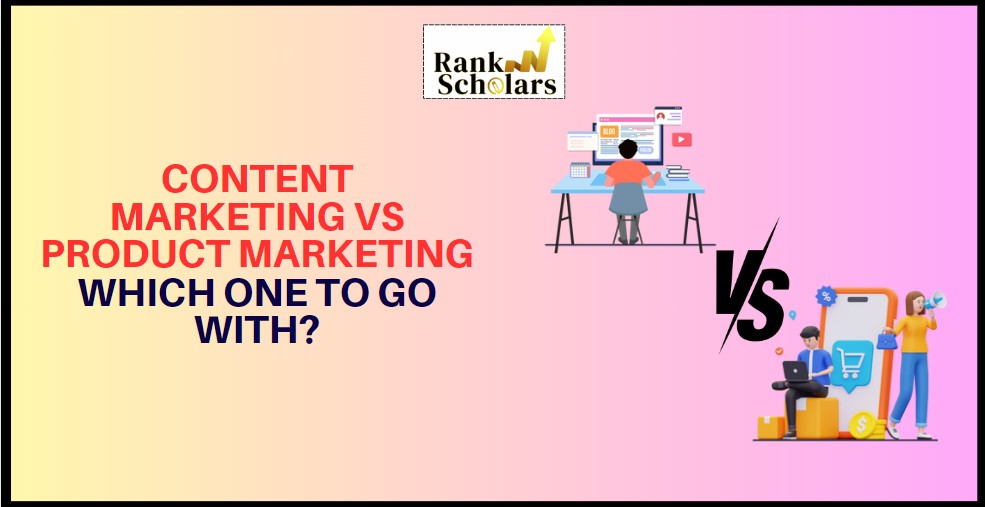You’ve been keeping up with the inspiring fitness journey of Blogilates‘ Cassey Ho. Her captivating YouTube videos on pilates workouts and fitness advice have become a go-to in your daily routine—this is content marketing in action.
Over the years, Cassey introduced her own line of fitness products under the brand Popflex. Think trendy & cute gym outfits, sturdy gym bags, or innovative yoga mats– all effortlessly integrated into her content and that’s product marketing.
As a business owner or marketer, you might struggle with deciding the best way to attract and convert your target audience into paying customers.
Should you focus on building a loyal following through valuable content, or should you highlight the unique features of your products directly to drive sales?
The goal of any marketing strategy is to attract and convert your target audience into paying customers.
In this blog, we’ve discussed the differences between content marketing vs product marketing in detail to help you decide which strategy or combination of strategies will best serve your business objectives.

What is Content Marketing?
Content marketing involves creating and sharing valuable content to drive products and services. The goal is to establish expertise and build brand awareness, even when your target audience isn’t looking to make a purchase yet.
Effective content marketing aligns content activities with business goals, addresses audience interests and pain points, prioritizes and plans content types, and continuously improves existing content. The main focus is to provide people with material that is valuable to them in terms of education, entertainment, and engagement.
For instance, a travel agency targeting adventure travelers might create blog posts on lesser-known destinations, videos of thrilling activities, and downloadable travel guides.
This valuable content establishes the brand as an authority in adventure travel and builds relationships with potential customers.
How Can Your Brand Embrace Content Marketing?
Embracing content marketing positions your brand ahead of competitors as it helps you build deeper connections with your audience. A company that embraces content marketing recognizes its potential to educate, entertain, and engage customers authentically.
To effectively integrate content marketing, start by aligning your content strategy with your business goals.
- Understand your audience’s needs and pain points to tailor content that resonates.
- Plan diverse content types such as blogs, videos, and social media posts that showcase your brand’s expertise and personality.
- Continuously refine your approach based on performance metrics and audience feedback to ensure relevance and impact.
When you consistently deliver valuable content across relevant channels, your brand builds credibility and strengthens customer loyalty over time.
Following these steps, your brand can effectively embrace content marketing, build strong relationships with your audience, and drive business growth.
What Are the Key Advantages of Content Marketing?
There are several benefits to content marketing that can help a company grow.
1. Enhanced Brand Visibility and Credibility
Consistently creating valuable content helps companies establish themselves as industry leaders.
2. Nurtures Long-Term Relationships
By addressing customer needs and providing ongoing value, content marketing fosters enduring connections with the audience.
3. Positioning as Trusted Information Sources
Content marketing portrays businesses as reliable and knowledgeable, influencing purchasing decisions early in the buyer’s journey.
4. Competitive Edge
Embracing content marketing enables companies to build deeper bonds with their audience, staying relevant and often outperforming competitors
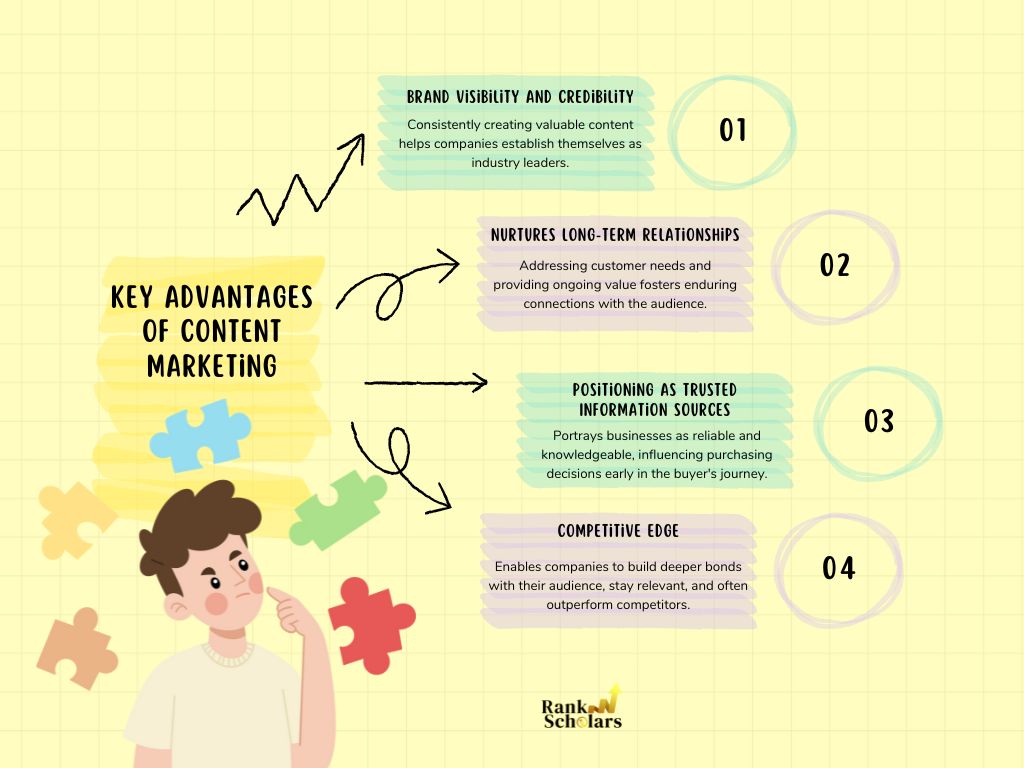
These advantages highlight the critical role of content marketing for businesses aiming to survive and thrive in the industry.
Content Marketing Channels
Several channels distribute content and engage with target audiences effectively through content marketing. These channels serve as platforms to reach and interact with potential customers across different stages of their buyer journey.
Here are some key content marketing channels,
Social media
Using Social media for content marketing provides businesses with dynamic avenues to reach and engage their target audience.
Sharing diverse content types such as text posts, images, videos, stories, and live streams, on platforms like Facebook, Instagram, LinkedIn, Twitter, and TikTok can help your business build communities, showcase brand personality, and interact directly with customers on a deeper level.
Website/blog
A business’s content marketing strategy is anchored by its website or blog, acting as a central hub for sharing valuable and in-depth information.
Through articles, case studies, and industry news, businesses can demonstrate their expertise and attract organic traffic. With long-form blog posts on your website, you can educate and inform readers, and build trust and credibility. By consistently updating content, you can engage their audience & improve search engine rankings.
Email/newsletters
Email newsletters enable businesses to deliver targeted content directly to subscribers’ inboxes. This personalized communication creates a strong bond with the customer and nurtures leads.
Newsletter content types include company updates, industry news, product announcements, exclusive offers, and educational articles. If you consistently provide valuable and relevant information through newsletters and keep the audience engaged, it will drive traffic to the website, and encourage repeat business.
Ebooks
Ebooks position brands as thought leaders and build credibility with their target audience. Ebooks allow businesses to provide in-depth information and comprehensive insights on specific topics.
Ebooks often include various content types, such as detailed articles, case studies, how-to guides, and infographics, packaged in a downloadable format. Ebooks serve as lead magnets, it captures potential customers’ contact information in exchange for access.
Infographics
Infographics are a powerful content type that combines visuals and text to present complex information clearly and concisely. They are ideal for sharing data, statistics, and step-by-step processes, making them easily digestible for audiences.
Infographics are highly shareable on social media, blogs, and websites. By transforming detailed information into visually appealing graphics, infographics help businesses communicate key messages effectively and capture the audience’s attention.
Videos
Videos effectively communicate complex information quickly making them ideal for boosting brand awareness. Videos as a content marketing channel enable businesses to connect with their audience in a visually engaging and emotionally resonant way.
YouTube, TikTok, and Instagram allow brands to share various content types, in both long-form as well as short-form content including product demonstrations, customer testimonials, educational tutorials, and behind-the-scenes glimpses.
Podcasts
Businesses can produce various types of content through podcasts, such as industry insights, expert interviews, storytelling, and educational series.
By delivering valuable audio content, podcasts help establish thought leadership, build a loyal listener base, and enhance brand credibility. This format allows businesses to reach busy professionals and enthusiasts who prefer listening over reading or watching.
Guest Blogging
Through guest blogging, businesses write and publish articles on external websites. Common content types for guest blogging include thought leadership pieces, how-to guides, industry analysis, and case studies.
By contributing valuable content to reputable sites, businesses can reach new audiences, build backlinks for SEO, and foster professional relationships within their industry.
Press Releases
Press releases serve as vital tools for announcing significant company updates, product launches, or newsworthy events. These concise documents are distributed to media outlets to garner press coverage and inform the public.
Effective press releases employ various content types, including compelling narratives, key statistics, and quotes from company spokespersons, to engage journalists and resonate with target audiences, thereby maximizing impact and coverage potential.
QnA Forums
Q&A forums are focused on addressing user queries related to your industry. They serve as hubs where users can find solutions, either from fellow users or your customer support team.
Keeping these forums open and accessible enhances their visibility on search engines like Google, ensuring they are easily discoverable by those seeking relevant information. Types of content on Q&A forums include troubleshooting guides, product recommendations, and discussions on industry trends, all aimed at providing valuable insights and support to users.
What is Product Marketing?
Product marketing is the process of promoting and selling a company’s products or services to its target audience. Product marketing involves thorough market research to understand customer needs and preferences, which informs the positioning of the product in the market.
For example, a fitness company launching a new line of smartwatches would conduct market research to identify key features that appeal to their target demographic, such as health tracking, battery life, GPS tracking, design aesthetics, and stylish, interchangeable bands.
Product marketing involves developing a market strategy that outlines how the product will be launched, priced, distributed, and promoted in the market. This strategy ensures that the product reaches the right audience through the most effective channels.
What Are The Key Advantages of Product Marketing?
There are several advantages of product marketing, including
1.Improves Customer Understanding
Product marketing improves customer understanding by identifying who the customers are, their pain points, and needed features, enabling businesses to tailor offerings effectively.
2. Builds Better Products and Services
It builds better products and services by prioritizing customer needs and experiences, enhancing overall value and market appeal, and leading to increased customer satisfaction.
3. Increases Sales
Product marketing increases sales by thoroughly understanding customer needs, creating optimized products, and positioning them effectively in the market.
4. Competitive Advantage
Product marketing creates a competitive advantage by highlighting the unique features and benefits of a product that resonate with the target audience.
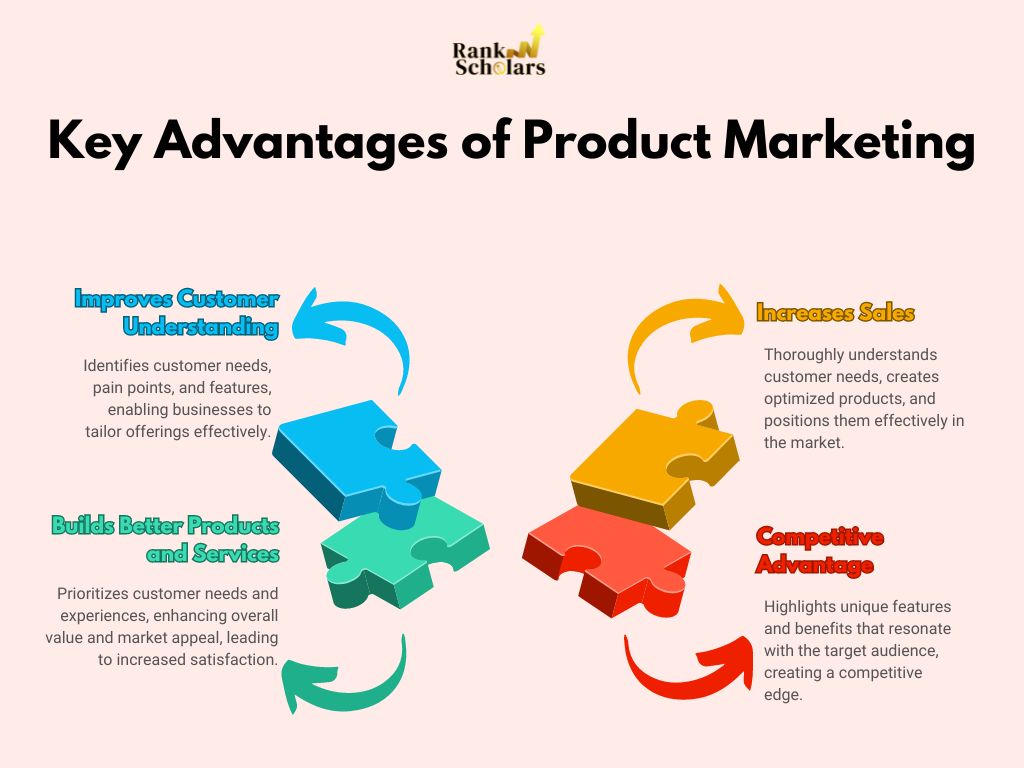
When is Product Marketing Appropriate?
Product marketing is appropriate at various stages of a product’s lifecycle including before launch, during the launch, and after the launch. Each stage requires specific strategies and activities to ensure the success of the product.
Before Product Launch
Before a product hits the market, product marketing is essential in understanding the market and preparing for a successful introduction.
This phase involves extensive market research to understand customer needs, preferences, and pain points. This information is used to develop a compelling value proposition and messaging that will resonate with the target audience.
Product marketing involves competitive analysis to understand the strengths and weaknesses of rival products, helping to position the new product effectively.
Pre-launch efforts also involve generating buzz and anticipation through teasers, sneak peeks, and early access opportunities, ensuring that the target market is aware of and excited about the upcoming product.
At Product Launch
During the product launch, product marketing activities are focused on a smooth and impactful entry into the market.
In this phase, you focus on executing the market strategy, that involves various promotional tactics such as advertising campaigns, public relations efforts, social media outreach, and launch events.
Keep the messaging consistent and compelling, highlighting the product’s unique selling points and any potential objections. You work closely with sales teams at this phase to provide them with the necessary tools, training, and collateral to effectively communicate the product’s value to customers.
The goal at this stage is to generate maximum visibility, drive initial sales, and set the tone for the product’s market presence.
After Product Launch
Product marketing doesn’t end after your target client has made a purchase. Post-launch, the marketing team puts an effort to shift towards sustaining momentum by keeping your audience engaged.
Focus on onboarding through emails and in-app messaging showcasing the product’s value and reassuring customers that they made the right purchase decision.
Continuous engagement with customers through updates and new features demonstrates value and responsiveness to feedback. Collecting customer feedback via surveys and showcasing testimonials helps refine strategies and build trust.
Addressing customer drop-offs with personalized outreach and special offers can re-engage and retain users.
Product Marketing channels
Here are some channels for your product marketing strategies to position your product effectively
Press Releases
Press releases are used to announce new products, updates, or significant company news. They aim to generate media coverage, increase brand visibility, and drive traffic to your website.
By providing newsworthy content with media coverage potential, press releases help position your product in the market and attract potential customers.
Product sheets, spec diagrams, and/or tear sheets
Product sheets, spec diagrams, and tear sheets offer detailed information about a product’s features, specifications, and benefits.
These materials serve as valuable resources for potential customers, providing a clear and concise overview of what the product offers. They are essential tools for sales teams, assisting in customer education and decision-making.
Sales Decks
Sales decks are presentations used by sales teams to communicate a product’s value proposition, key features, and benefits to potential customers.
These decks typically include detailed product information, use cases, and customer testimonials, helping to persuade and educate prospects, boosting purchasing decisions, and supporting the overall sales strategy.
Paid Ads
Paid advertising is a powerful product marketing channel. It involves promoting your product through paid placements on search engines, social media platforms, and other websites.
These ads target specific audiences based on demographics, interests, and behaviors, helping to increase product visibility, drive traffic, and generate leads quickly. Effective ad campaigns can significantly boost sales and brand recognition.
Landing Pages
Landing pages are dedicated web pages designed to capture leads and drive conversions. They provide focused information about a specific product or offer, highlighting its features and benefits.
With clear calls-to-action (CTAs), landing pages guide visitors toward taking desired actions, such as signing up for a newsletter, downloading a resource, or making a purchase.
Infographics and blog posts
Infographics visually present complex information, making it easily digestible and shareable, which boosts engagement. Blog posts provide in-depth content, addressing customer pain points, showcasing product features, and improving SEO.
Both channels help educate the audience, establish authority, and drive traffic to your product.
Case studies
Case studies are detailed narratives that showcase how your product or service has successfully solved a specific problem for a customer. They provide real-world examples of your product, demonstrating its effectiveness and value.
Case studies are valuable for showcasing expertise, and influencing potential customers by illustrating tangible benefits and outcomes.
Testimonials
Testimonials are feedback from satisfied customers that express the value and quality of a product or service. They provide social proof, building trust and credibility among potential buyers.
Testimonials influence purchasing decisions by showcasing real experiences and positive outcomes from using the product or service.
In-Product Marketing
This involves promoting and educating users about features, updates, and benefits directly within the product interface.
It aims to enhance user experience, drive product adoption, and increase engagement by strategically placing messages, tutorials, and prompts within the product itself.
This approach ensures that users receive relevant information at the right time, maximizing their interaction and satisfaction.
Product Marketing Vs Content Marketing – What’s the Difference?
Businesses employ a variety of strategies to gain the attention of the audience and drive growth. Two of the most powerful yet distinct approaches are product marketing and content marketing. While they both aim to connect with customers and enhance brand presence, there are significant differences in their methods and objectives.
Product Marketing focuses on promoting and selling specific products or services. It involves understanding customer needs, crafting compelling messaging, and developing market strategies to position the product effectively.
Product marketing ensures to drive sales and that the product meets market demands.
For example, product marketing for a new smartphone includes highlighting its unique features, creating targeted advertising campaigns, and training sales teams.
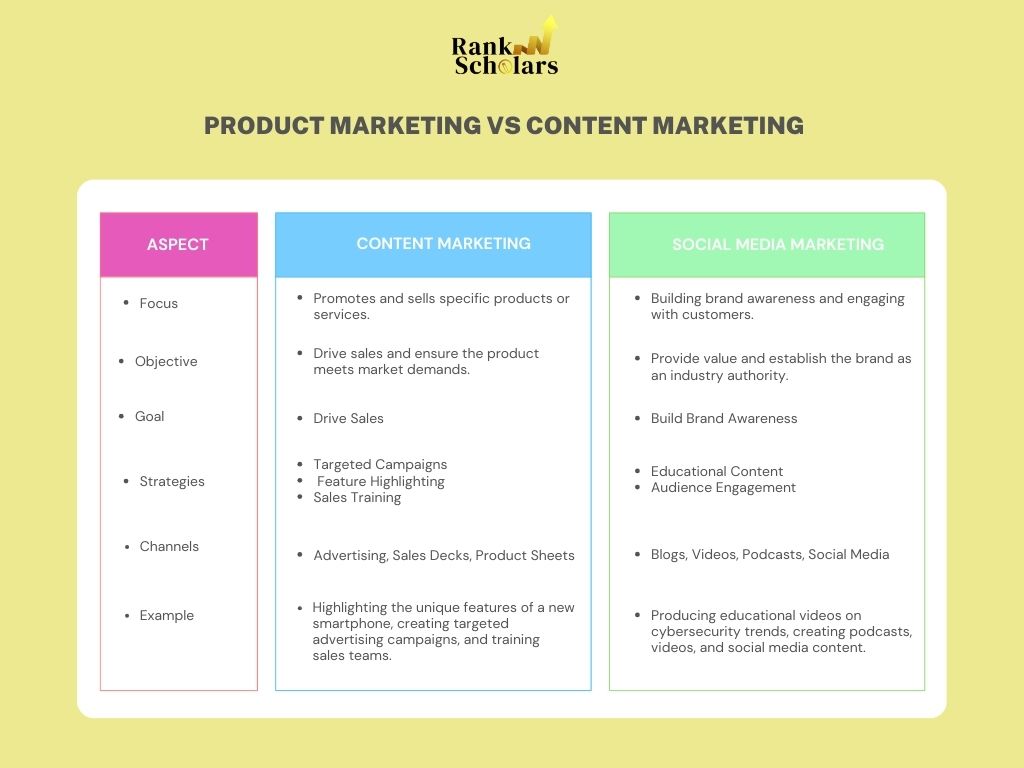
Content Marketing, on the other hand, aims to build brand awareness and engage with customers by creating and sharing valuable content. The focus is on educating, entertaining, and engaging the audience rather than directly promoting a product.
Content marketing includes podcasts, videos, social media content, and more, all designed to provide value and establish the brand as an industry authority.
For instance, a tech company might produce educational videos on cybersecurity trends to engage its audience and build trust.
Sales Funnel: Top Vs Bottom
Content marketing predominantly operates at the top of the funnel, focusing on building awareness and attracting a broad audience.
Through educational blog posts, informative videos, engaging social media content, and podcasts, content marketing aims to gain the attention of potential prospects who are in the early stages of their buying journey.
The goal is to establish brand authority, educate the audience about industry trends, and address their pain points without directly promoting specific products or services.
On the other hand, product marketing is a bottom of the funnel strategy that targets customers who are closer to making a purchase decision.
It involves promoting specific products or services through targeted campaigns, product demonstrations, personalized emails, and sales presentations. It includes emphasizing the unique features, benefits, and value propositions of the offerings to convince potential customers to convert.
Unlike content marketing, which aims to attract and engage a broad audience, product marketing focuses on nurturing leads and guiding them through the final stages of the buying process.
While content marketing casts a wide net to capture and educate prospects at the top of the funnel, product marketing directs efforts toward converting those prospects into paying customers at the bottom of the funnel.
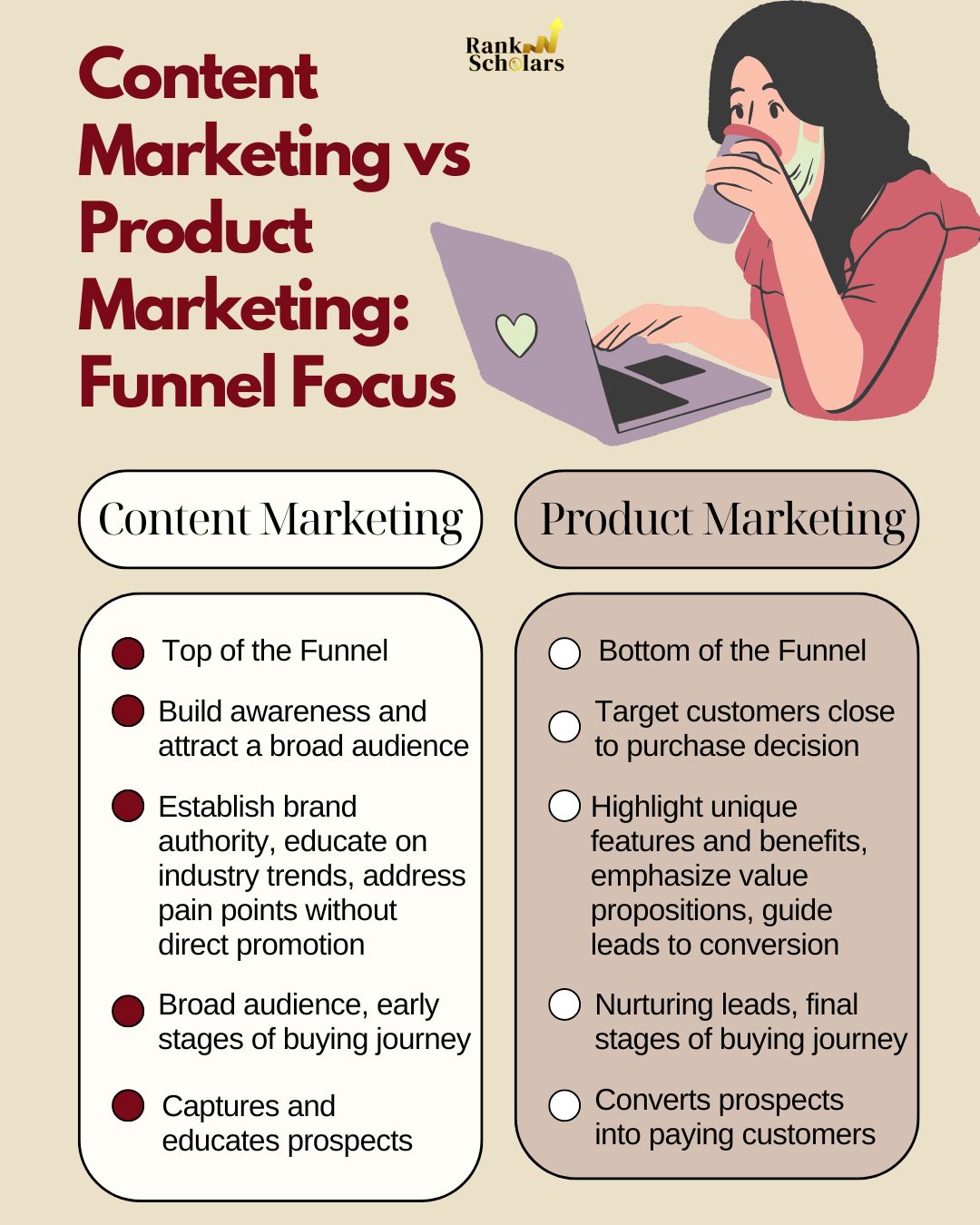
Both strategies are essential components of a comprehensive marketing plan aimed at driving sales and fostering customer relationships throughout the entire sales funnel journey.
Final Words
Understanding the distinct roles of content marketing vs product marketing within your sales strategy is crucial for driving growth and achieving your business goals. Content marketing helps to attract and engage a wide audience by building brand awareness, and nurturing relationships. Product marketing, on the other hand, focuses on converting engaged prospects into loyal customers through targeted promotions and detailed product information.
If you’re looking to enhance your content marketing efforts, Rank Scholars offers top-notch content marketing services tailored to your unique needs. Our team of experts will help you create compelling, valuable content that educates, entertains, and engages your audience, positioning your brand as an industry authority.
Let us guide your content marketing strategy and take your business to the next level. Book a demo call with us today to start building meaningful connections with your audience and driving long-term success.

Sahanaj is a content writer who is passionate about turning ideas into words that inspire positive change.

